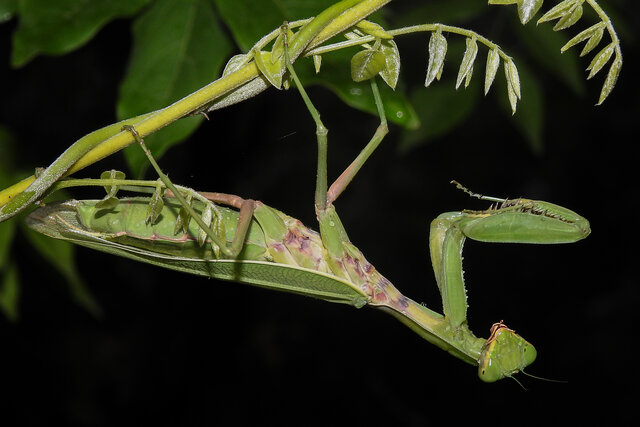Specimens of the invasive species are appearing in more and more places in our country - however, it is not yet known what the consequences of the settlement of the newcomers will be.
The giant Asian praying mantis (Hierodula tenuidentata) is an insect the size of a ballpoint pen, with a spectacular, mostly green, but sometimes brownish or yellowish body, which attracts people's attention with its appearance and anthropomorphic features. Long-lived females are most often seen, leaving the canopy of trees in autumn to lay eggs or sunbathe. They are often seen on the trunks of trees with smooth bark or on sunny walls shortly before they die with the onset of the first frosty nights.
Until recently, only one species of pincer was known in Hungary, but for example, there are already four species in Romania, and at least twice as many in the Balkans. Three dozen species are known in Europe.
The first known domestic specimen appeared in a garden in Zákányszék in the Csongrád-Csanád county in 2019. In the following years, eggs and larvae of the species were found in Zákányszék, proving its settlement. In 2020, an adult specimen was also found in Budapest and South Buda, the find was followed by more in 2021 and 2022. In the autumn of 2021, several large female Hierodula caused a stir in the Városliget as they sunned themselves on the trunks of the sycamore trees. In addition to the sightings in Budapest, sightings from Zákányszék and other settlements in the Southern Great Plain have also been continuously collected over the past two years.
The giant Asian praying mantis has settled stably in Szeged and the smaller settlements bordering it to the west, and its appearance in Kiskunhalas in 2022 proves its further spread.
There are several possibilities regarding how Hierodula tenuidentata arrived in Hungary. In addition to the adult males, the colonizing females are also capable of flight (until their bellies swell with dozens of eggs), so the first specimens could have arrived in the vicinity of Szeged on their own, from the direction of Serbia.
The occurrences in Budapest, which for now seem like islands, can certainly be explained by human intervention, based on the locations (freshly landscaped areas), it is most likely that they were brought in attached to ornamental trees or shrubs.
The impact of the giant Asian praying mantis on the European fauna is still questionable. For humans, the new arrival is completely harmless, and in principle, its presence in the garden can even be beneficial by destroying pests hiding in the canopy, including invasive bug trees.
While the new species lives primarily in the foliage of trees and shrubs, the native praying mantis is more likely to inhabit the herbaceous vegetation of open areas. Their different habitat preferences reduce the chance of competition between the two species, but it is a cause for concern that the pheromones of the invasive species' females also attract native praying mantis males, reducing their chances of reproduction, the Hungarian Museum of Natural History points out in the blog.













